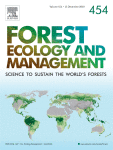Ver ítem
- xmlui.general.dspace_homeCentros Regionales y EEAsCentro Regional Buenos Aires SurEEA BalcarceArtículos científicosxmlui.ArtifactBrowser.ItemViewer.trail
- Inicio
- Centros Regionales y EEAs
- Centro Regional Buenos Aires Sur
- EEA Balcarce
- Artículos científicos
- Ver ítem
New insights into wood anatomy and function relationships: how Eucalyptus challenges what we already know
Resumen
Multispecies surveys have shown that there is a weak but significant trade-off between xylem efficiency and safety in woody species, with no species maximizing both attributes at the same time. Relationships between xylem structure and function are studied mostly at the interspecific level, with few studies considering the relationships at the intraspecific level, particularly in angiosperms. Studies have shown that
relationships between xylem anatomy or
[ver mas...]
Multispecies surveys have shown that there is a weak but significant trade-off between xylem efficiency and safety in woody species, with no species maximizing both attributes at the same time. Relationships between xylem structure and function are studied mostly at the interspecific level, with few studies considering the relationships at the intraspecific level, particularly in angiosperms. Studies have shown that
relationships between xylem anatomy or Wood density and vulnerability to cavitation (which determines xylem safety) observed in multi-species surveys may be different to those observed within a species. This raises the question about the value of
multispecies studies to shed light over what is adaptive within a given species, the organization level at which natural and human selection operates. To contribute to this debate, we studied xylem structure and function in four Eucalyptus species, and made
focus within one of them, E. globulus, to determine if patterns observed at the interspecific level are also held within a species. Eucalyptus species have a xylem composed by solitary vessels surrounded and connected to imperforate tracheary cells and parenchyma, a particular anatomy poorly known in terms of its function. Correlation analyses revealed that the trends observed between vessel size (mean and distribution) and vulnerability to cavitation are similar at the interspecific and intraspecific levels. Moreover, no trade-off has been observed between xylem efficiency (maximum hydraulic conductivity) and safety (water potential at 12% and 50% of hydraulic conductivity loss), but the opposite trend: individuals with mean larger vessels presented lower vulnerability to cavitation. Cells around vessels (parenchyma, vasicentric tracheids, fibertracheids) could be involved in this phenomenon since they
correlate both with maximum hydraulic conductivity (positively) and vulnerability to cavitation (negatively) at the interspecific level. In addition, large xylem vessels presented smaller pits than small xylem vessels. This suggests that pit size is involved
in the lack of trade-off between xylem safety and efficiency. Finally, vulnerability to cavitation was correlated with branch and stem wood density of the same tree, but correlations had opposite sign depending on the plant organ. These results provide
new insights into the relationships between wood structure and function of angiosperm species.
[Cerrar]

Autor
Fernandez, María Elena;
Barotto, Antonio José;
Martinez Meier, Alejandro;
Gyenge, Javier;
Teson, Natalia;
Quiñones Martorello, Adriana;
Merlo, Esther;
Dalla Salda, Guillermina;
Rozenberg, Philippe;
Monteoliva, Silvia Estela;
Fuente
Forest Ecology and Management 454 : 117638 (2019)
Fecha
2019-12-15
Editorial
Elsevier
ISSN
0378-1127
Formato
pdf
Tipo de documento
artículo
Palabras Claves
Derechos de acceso
Restringido
 Excepto donde se diga explicitamente, este item se publica bajo la siguiente descripción: Creative Commons Attribution-NonCommercial-ShareAlike 2.5 Unported (CC BY-NC-SA 2.5)
Excepto donde se diga explicitamente, este item se publica bajo la siguiente descripción: Creative Commons Attribution-NonCommercial-ShareAlike 2.5 Unported (CC BY-NC-SA 2.5)

